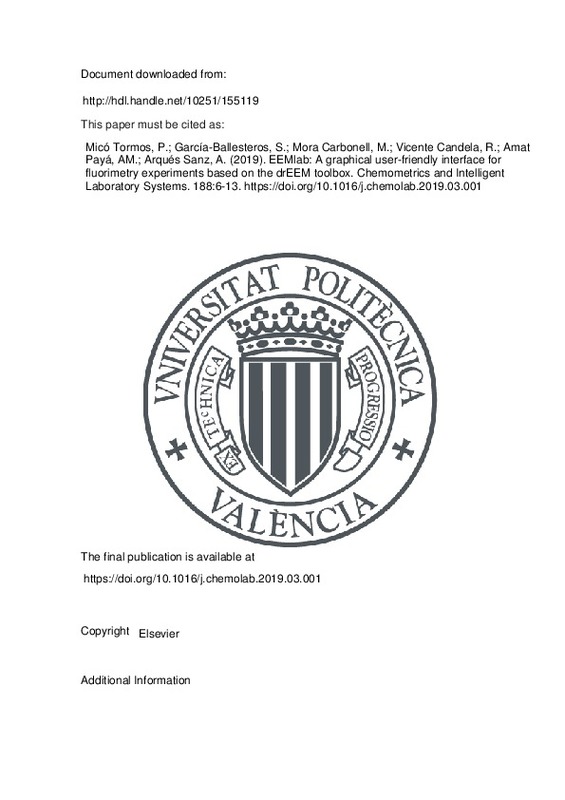JavaScript is disabled for your browser. Some features of this site may not work without it.
Buscar en RiuNet
Listar
Mi cuenta
Estadísticas
Ayuda RiuNet
Admin. UPV
EEMlab: A graphical user-friendly interface for fluorimetry experiments based on the drEEM toolbox
Mostrar el registro sencillo del ítem
Ficheros en el ítem
| dc.contributor.author | Micó Tormos, Pau
|
es_ES |
| dc.contributor.author | García-Ballesteros, Sara
|
es_ES |
| dc.contributor.author | Mora Carbonell, Margarita
|
es_ES |
| dc.contributor.author | Vicente Candela, Rafael
|
es_ES |
| dc.contributor.author | Amat Payá, Ana María
|
es_ES |
| dc.contributor.author | Arqués Sanz, Antonio
|
es_ES |
| dc.date.accessioned | 2020-11-17T04:32:10Z | |
| dc.date.available | 2020-11-17T04:32:10Z | |
| dc.date.issued | 2019-05-15 | es_ES |
| dc.identifier.issn | 0169-7439 | es_ES |
| dc.identifier.uri | http://hdl.handle.net/10251/155119 | |
| dc.description.abstract | [EN] Fluorescence has been widely employed for the characterization of organic matter. In particular, excitation emission matrixes (EEM) provide important qualitative information on its composition. However, the application of this technique is limited by the mathematical complexity involved, which requires the use of PARAFAC for deconvolution of the EEM in their components. To overcome the numerical problem specific MATLAB toolboxes for the PARAFAC deconvolution have been implemented (e.g. drEEM). This toolbox is widely used by the scientific community but its intrinsic complexity in terms of programming knowledge makes it difficult to use. In this regard and in order to facilitate the first approximation to the PARAFAC programming problem, this paper describes and offers to the community the EEMlab software application: a graphical user-firendly interface for fluorimetry experiments based on the drEEM toolbox. The interface is developed in order to facilitate not only the intuitive use of the drEEM (no previous MATLAB knowledge is needed) but also to automate many repetitive tasks (as the data load or the modeling loop) or even to manage the different formats of files being produced by all the devices involved in the process. In order to validate the EEMlab, the same experiment documented by the drEEM is reproduced. In addition, the EEMlab is tested again with conducting a new fluorimetry experiment and the results are presented at the end of the paper. Finally to appoint a reference to the public web site pabmitor.webs.upv.es/eemlab in where all the components of the EEMlab GUI (software, tutorial and datasets) are publicly available to the readers. | es_ES |
| dc.description.sponsorship | The authors want to thank the financial support of the Generalitat Valenciana, Conselleria d'Educacio, Cultura i Esport (Spain) [GV/2015/074]. The authors want to thank the financial support of Ministerio de Educacion y Ciencia (Spain)(CTQ2015-69832-C4-4-R). Sara Garcia-Ballesteros would like to thank Ministerio de Economia y Competitividad (Spain) for her fellowship (BES-2013-066201). The authors want to thank Dr. F.S. García Einschlag who has independently tested the EEMlab and helped the authors to improve and validate the final version of the application. | es_ES |
| dc.language | Inglés | es_ES |
| dc.publisher | Elsevier | es_ES |
| dc.relation.ispartof | Chemometrics and Intelligent Laboratory Systems | es_ES |
| dc.rights | Reconocimiento - No comercial - Sin obra derivada (by-nc-nd) | es_ES |
| dc.subject | Excitation-emission matrix (EEM) | es_ES |
| dc.subject | Fluorescent experiment | es_ES |
| dc.subject | Composition of complex samples | es_ES |
| dc.subject | Mathematical deconvolution of data | es_ES |
| dc.subject | Multifluorophoric mixtures | es_ES |
| dc.subject.classification | QUIMICA FISICA | es_ES |
| dc.subject.classification | ARQUITECTURA Y TECNOLOGIA DE COMPUTADORES | es_ES |
| dc.subject.classification | MATEMATICA APLICADA | es_ES |
| dc.title | EEMlab: A graphical user-friendly interface for fluorimetry experiments based on the drEEM toolbox | es_ES |
| dc.type | Artículo | es_ES |
| dc.identifier.doi | 10.1016/j.chemolab.2019.03.001 | es_ES |
| dc.relation.projectID | info:eu-repo/grantAgreement/MINECO//BES-2013-066201/ES/BES-2013-066201/ | es_ES |
| dc.relation.projectID | info:eu-repo/grantAgreement/GVA//GV%2F2015%2F074/ | es_ES |
| dc.relation.projectID | info:eu-repo/grantAgreement/MINECO//CTQ2015-69832-C4-4-R/ES/TECNOLOGIAS EFICIENTES PARA LA ELIMINACION DE CONTAMINANTES DE PREOCUPACION EMERGENTE, CONTENIDOS EN DIRECTIVA 2013%2F39%2FCE O DE RIESGO SIGNIFICATIVO SEGUN DIRECTIVA 2008%2F105%2FCE/ | es_ES |
| dc.rights.accessRights | Abierto | es_ES |
| dc.contributor.affiliation | Universitat Politècnica de València. Departamento de Matemática Aplicada - Departament de Matemàtica Aplicada | es_ES |
| dc.contributor.affiliation | Universitat Politècnica de València. Departamento de Ingeniería Textil y Papelera - Departament d'Enginyeria Tèxtil i Paperera | es_ES |
| dc.contributor.affiliation | Universitat Politècnica de València. Departamento de Informática de Sistemas y Computadores - Departament d'Informàtica de Sistemes i Computadors | es_ES |
| dc.description.bibliographicCitation | Micó Tormos, P.; García-Ballesteros, S.; Mora Carbonell, M.; Vicente Candela, R.; Amat Payá, AM.; Arqués Sanz, A. (2019). EEMlab: A graphical user-friendly interface for fluorimetry experiments based on the drEEM toolbox. Chemometrics and Intelligent Laboratory Systems. 188:6-13. https://doi.org/10.1016/j.chemolab.2019.03.001 | es_ES |
| dc.description.accrualMethod | S | es_ES |
| dc.relation.publisherversion | https://doi.org/10.1016/j.chemolab.2019.03.001 | es_ES |
| dc.description.upvformatpinicio | 6 | es_ES |
| dc.description.upvformatpfin | 13 | es_ES |
| dc.type.version | info:eu-repo/semantics/publishedVersion | es_ES |
| dc.description.volume | 188 | es_ES |
| dc.relation.pasarela | S\380528 | es_ES |
| dc.contributor.funder | Generalitat Valenciana | es_ES |
| dc.contributor.funder | Ministerio de Economía y Competitividad | es_ES |







![[Cerrado]](/themes/UPV/images/candado.png)

